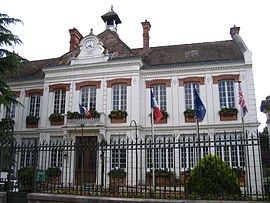Vulaines-sur-Seine | |
|---|---|
 The town hall in Vulaines-sur-Seine | |
| Coordinates: 48°25′55″N 2°46′03″E / 48.4319°N 2.7675°E | |
| Country | France |
| Region | Île-de-France |
| Department | Seine-et-Marne |
| Arrondissement | Fontainebleau |
| Canton | Fontainebleau |
| Intercommunality | Pays de Fontainebleau |
| Government | |
| • Mayor (2020–2026) | Patrick Chadaillat[1] |
| Area 1 | 4.42 km2 (1.71 sq mi) |
| Population (2021)[2] | 2,731 |
| • Density | 620/km2 (1,600/sq mi) |
| Time zone | UTC+01:00 (CET) |
| • Summer (DST) | UTC+02:00 (CEST) |
| INSEE/Postal code | 77533 /77870 |
| Elevation | 42–104 m (138–341 ft) |
| 1 French Land Register data, which excludes lakes, ponds, glaciers > 1 km2 (0.386 sq mi or 247 acres) and river estuaries. | |
Vulaines-sur-Seine (French pronunciation: [vylɛn syʁ sɛn] , literally Vulaines on Seine) is a commune in the Seine-et-Marne department in the Île-de-France region in north-central France.
French symbolist poet Stéphane Mallarmé died there in September 1898.
Twin towns
[edit]It is twinned with the village of Barby, Northamptonshire, United Kingdom.[3]
Population
[edit]Inhabitants of Vulaines-sur-Seine are called Vulaignots.
| Year | Pop. | ±% p.a. |
|---|---|---|
| 1968 | 903 | — |
| 1975 | 1,107 | +2.95% |
| 1982 | 1,685 | +6.19% |
| 1990 | 2,047 | +2.46% |
| 1999 | 2,065 | +0.10% |
| 2007 | 2,466 | +2.24% |
| 2012 | 2,645 | +1.41% |
| 2017 | 2,722 | +0.58% |
| Source: INSEE[4] | ||
See also
[edit]References
[edit]- ^ "Répertoire national des élus: les maires" (in French). data.gouv.fr, Plateforme ouverte des données publiques françaises. 13 September 2022.
- ^ "Populations légales 2021" (in French). The National Institute of Statistics and Economic Studies. 28 December 2023.
- ^ "Barby Twinning Association". Barby and Onley Parish Council. Retrieved 16 April 2019.
- ^ Population en historique depuis 1968, INSEE
External links
[edit]- Base Mérimée: Search for heritage in the commune, Ministère français de la Culture. (in French)




Well, that’s interesting to know that Psilotum nudum are known as whisk ferns. Psilotum nudum is the commoner species of the two. While the P. flaccidum is a rare species and is found in the tropical islands. Both the species are usually epiphytic in habit and grow upon tree ferns. These species may also be terrestrial and grow in humus or in the crevices of the rocks.
View the detailed Guide of Psilotum nudum: Detailed Study Of Psilotum Nudum (Whisk Fern), Classification, Anatomy, Reproduction